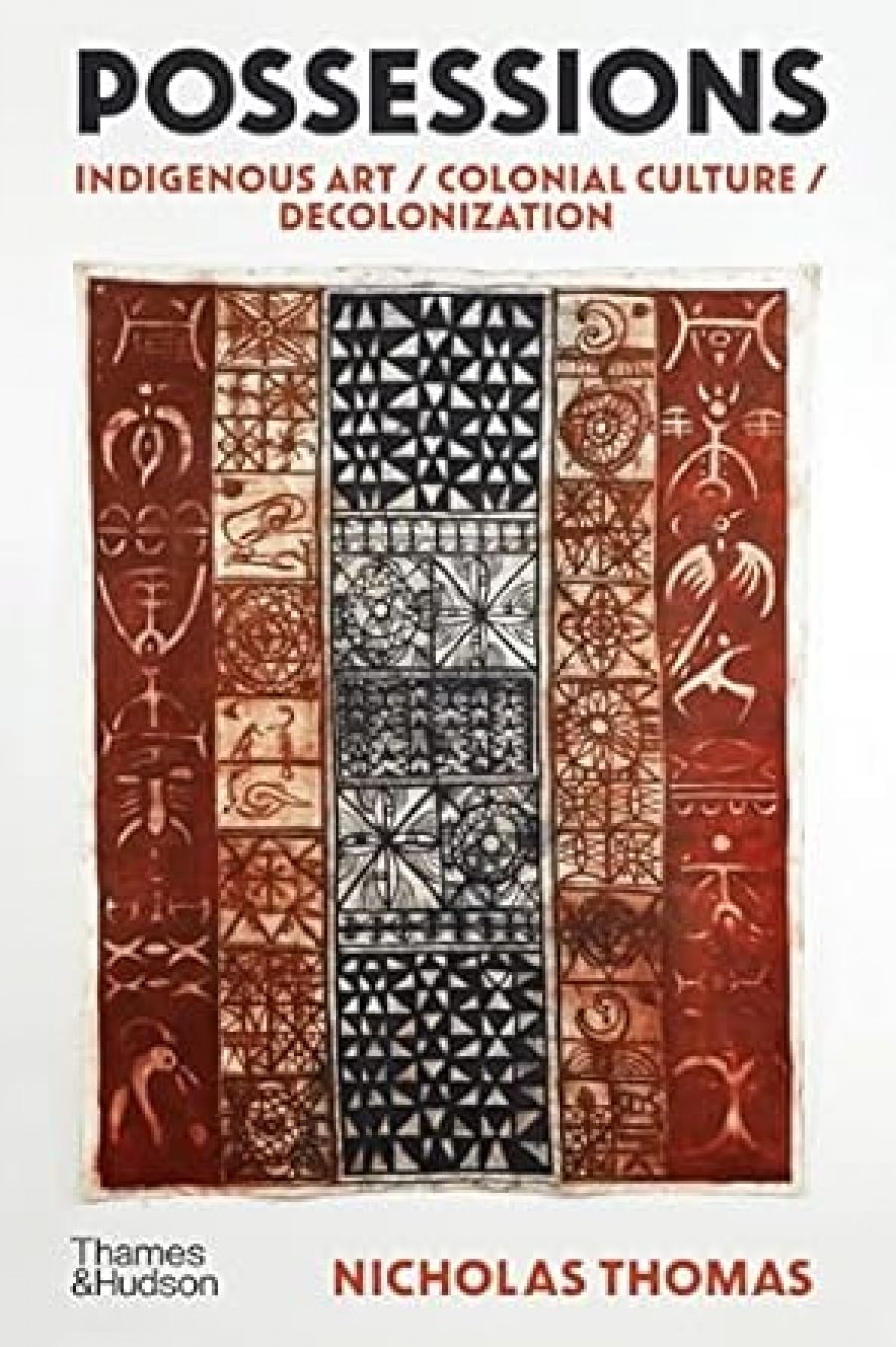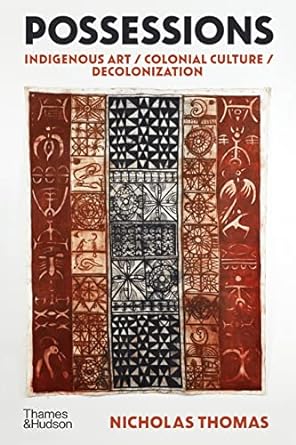
- Free Article: No
- Contents Category: Indigenous Studies
- Review Article: Yes
- Article Title: Intimate Antagonism
- Online Only: No
- Custom Highlight Text:
Nick Thomas is arguably the outstanding academic of international repute at present working in the humanities and social sciences in Australia, as attested by his receipt of the 1998 Royal Anthropological Institute’s Rivers Memorial Medal for exceptional achievement of publications’. He is certainly prolific: Possessions is his eighth single-authored scholarly book in thirteen years. Thomas’ work is eclectic in discipline, interests and style. His themes range from Pacific history to anthropological theory, to postcolonial cultural history and critique, to art. The ambiguous intersections of local and colonial histories and cultures are a persistent concern, with increasing focus on material objects and the visual. He is equally adept with academic arcana as with a prose style directed to that publisher’s ideal, the educated non-specialist.
- Book 1 Title: Possessions
- Book 1 Subtitle: Indigenous Art/Colonial Culture
- Book 1 Biblio: Thames and Hudson, $39.95 pb, 304 pp
- Book 1 Cover Small (400 x 600):

Though not exactly light reading, Possessions will appeal to this target audience: always contentious, it wears its undoubted scholarship lightly – not overburdened with references or theory – and is sumptuously produced and illustrated. It may not please many conventional art historians and critics or some anthropologists. And it will outrage conservatives for its pro-indigenous politics and aspersions on white settlement and nationalism in Australia and Aotearoa New Zealand. Yet this is not another purely oppositional indictment of monolithic ongoing colonialism, fed by elegiac regret for the death of the hapless primitive. Thomas’ self-proclaimed binary emphasis on ‘the intimate antagonism between settlers and indigenous peoples’ – the ‘fraught and fertile’ contradiction which defines antipodean cultures – is altogether more subtle and ambiguous. It is condensed in the slipperiness and inversions of a central ‘and/or’ relation, that of ‘native and/or national identity’, connoting the complex ‘interplay of dispossession and repossession’ in settler societies, whereby settler recourse to indigenous reference in seeking to define a distinctive national culture draws notice to the ‘real natives’, who may creatively reappropriate such local signs to assert indigenous precedence and sovereignty.
This book is unusual in scope and ambition, interweaving several related narratives. It is a history of European primitivism, not from metropolitan or global perspectives, but from the ‘distinctive, local vantage point’ of certain settler countries, invoking a basic contrast between the eclectic, revitalising logic of modernist primitivism and the localised, romantic national mission of settler varieties. It is a ‘cross-cultural art history’ of settler and indigenous works (plus, somewhat parenthetically, recent diasporic migrant art), signalling moments of ‘dialogue’, ‘exchange’, and ‘awkward if not antagonistic intimacy’, which destabilise colonial certitude and qualify the general violence and dispossession of colonisation. It is a comparison of different antipodean settings, notably of the charged specifics of indigenous reference in colonial and settler art: in bicultural Aotearoa New Zealand Thomas discerns ‘a continuum connecting celebration and denigration’, in contrast to multicultural Australia’s ‘grotesque antithesis’ of ‘affirmation’ of Aboriginal ‘forms and motifs’, and antipathy to Aboriginal people. It is above all a sustained celebration of the creative dynamic whereby Aboriginal and Māori artists have yoked ‘traditional’ and novel themes, media, techniques and opportunities to produce art of astonishing variety and vitality, transcending the conventional antinomy of ‘traditional’ and ‘contemporary’ in a vigorous’ co-presence’ that challenges ‘not only ... the categories that inform art-world hierarchies, but ... the invidious distinctions of settler-colonial culture itself’.
The author’s heroes are mostly indigenous, including obvious candidates like Gordon Bennett, Rover Thomas and Emily Kame Kngwarreye, plus several Māori modernists, a raft of public and popular Māori artists, the Niuean John Pule, and, less fashionably, Albert Namatjira and the Hermannsburg school. Yet there is also qualified sympathy for the ambivalent forays into indigenous reference of some settler artists who have otherwise evoked the diametric responses of nationalist hagiography or radical/indigenous obloquy. They include Augustus Earle, Eugene von Guerard and Margaret Preston in Australia – but not the Heidelberg school, whose nationalist project to represent ‘familiar bush’, near towns, ‘almost totally excluded Aboriginal people’ – and Colin McCahon and Gordon Walters in New Zealand. For Thomas, their ‘lurching’ between effacement of indigenous people and appropriation/appreciation of elements of indigenous culture betokens
a basic, multifaceted ambivalence around the denial and affirmation of the indigenous presence, around the virtue and illegitimacy of colonial settlement, that runs deep ... [and] is foundational in settler culture.
Though aesthetic quality is an implicit ground for qualifying critique of the dubious politics of some white settler artists (especially Preston and Walters), the author’s interests and intentions are political rather than aesthetic: ‘aesthetic issues’ are only significant insofar as they enhance ‘respect’ for indigenous culture and recognition’ for indigenous political claims. So far as indigenous and migrant art is concerned, the tone ranges from sympathetic to celebratory of the purported politics, and political affirmation is generally echoed in aesthetic adjudications. The only non-settler art practitioners to rate mild opprobrium are recent Australian diasporic artists who are seen to disparage indigenous artists ‘for being too traditional, for failing the test of hybrid sophistication’, and whose ‘projects at best seem to ignore those of Aborigines, and may in fact subvert them’. Approbation is taken to the point of tedium for this reader in ‘Chapter Seven’, which adopts an autobiographical, diary mode to explore the proliferation of Māori popular art beyond galleries and beyond ‘the terms of art criticism’. In certain respects, then, the book lacks a critical edge. But this chapter also signals some of its considerable strengths: Thomas’ refusal to limit his compass to ‘high art’; his injection of regular doses of reflexivity; his impatience with art history’s concern for form and periodisation to the exclusion of ‘content’, ‘the world’, and ‘particular worlds’; his unease with the rarefied, political ingenuousness or asepsis of much art criticism and culture theory, particularly dominant postmodernist varieties.
In sum, this is a wide-ranging work with multiple salience – for an history and critique, anthropology, colonial and indigenous studies, and the politics of reconciliation and redress in settler countries. It is also well and engagingly written, and deserves to reach the wide audience to whom it is pitched.


Comments powered by CComment